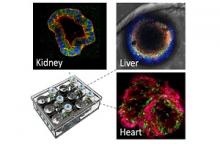- About us
- Research
- Students & Teaching
- Seminars & Events
- Directories
- Booking Rooms & Equipment
- עברית
Home » Prof. Nahmias chips away at nephrotoxicity
Tissue-on-a-chip technology can help elucidate mechanisms of drug-induced toxicity.
Prof. Nahmias and his team used vascularized human kidney spheroids-on-a-chip and embedded sensors to monitor cellular metabolism in response to drug treatments.
They found that proximal tubule polarity was disrupted and toxicity resulted from glucose accumulation upon exposure to cyclosporine and cisplatin, which could be prevented by inhibiting glucose reabsorption. Glomerular filtration rates were higher and markers of kidney damage were lower in patients treated with cyclosporine or cisplatin in combination with a sodium-glucose cotransporter-2 inhibitor.
These results demonstrate the potential of sensor-integrated kidney-on-chip platforms to elucidate mechanisms of action and rapidly reformulate effective therapeutic solutions, increasing drug safety and reducing the cost of clinical and commercial failures.
